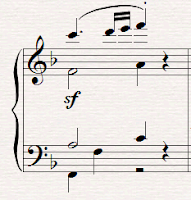In the exposition, these measures feature the main theme in F major, modulating to C major. Here, the main theme enters abruptly in D-flat major. The appearance of the B natural in measure 106 converts the D-flat chord into a German sixth, which resolves, on the downbeat of measure 107, to the dominant of F major. Thus Beethoven has performed the customary Viennese Classical trick of retaining the modulatory feel of the bridge without actually modulating. Despite the jolt when the theme enters in D-flat major, we wind up right back in F major where we started.
Here is what a literal transcription would sound like. (Measures 101 and 102 are taken from Beethoven's actual arrangement of the exposition.)
There are two problems with this transcription: (1) It is not as energetic as the piano version. The long, held notes bogs the passage down, especially in measures 105 and 106. (2) There are parallel fifths between the second violin and cello leading into measure 103, and it's not easy to see how to fix them. The second violin's G can't resolve to an F, because the violin can't go that low. And dropping the second violin out and leaving the G hanging would sound strange.
Beethoven fixes both these problems with his arrangement.
First, the technical problem. Beethoven does avoid the parallel fifths by resolving the second violin's G to an F, but he resolves it to a high F, bringing the second violin up above the first violin. He then makes the F a quarter note to get out of the way of the melody, which seems to emerge unexpectedly from the texture. This emergence quality is enhanced by the B flat at the end of measure 101, which makes the theme a continuation of the soprano line rather than the disjoint entity we hear in the piano version. The disjointedness in this arrangement comes not from the voice leading, as in the piano version, but from the dynamics. Beethoven changes the diminuendo in measure 102 to a crescendo, so the ensuing pianissimo offers more of a jolt.
How does Beethoven keep the energy high in the remaining measures? In measures 103 to 104, he presents the melody in a single line (rather than the chords of the piano version) and distributes the energetic accompaniment among all three lower strings. The extra voices give him some additional flexibility. For one thing, they enable him to retain the pedal tone in the lower octave. Rather than run up to the high D flat, Beethoven keeps the cello on the low D flat and changes the sixteenth-note run into a trill. The second violin and viola take over the eighth note figure at the end of the measure, which become rising chords rather than a restatement of the pedal tone.
In measures 105-106, Beethoven makes some changes to the run in the first violin. As usual, for ensemble purposes, he has the run begin on the downbeat, eliminating the sixteenth note rest. But this change renders measure 107 problematic. Since we have heard the same rhythm (an eighth and two sixteenths) on beats one and three of measure 105, we expect to hear the that rhythm a third time in measure 106. Beethoven accommodates us by shifting the sixteenth notes of measure 106 over half a beat. He then fills out the extra half beat by adding a turn on beat three.
As for the accompaniment, we observed earlier that the cello's long D flat in the transcription bogs these measures down. So Beethoven replaces the long D flat with a descent from D flat to B natural, doubled by the viola. This new line delays the German sixth until beat three of measure 106. Beethoven highlights its arrival with a sforzando and double stops in the second violin.







